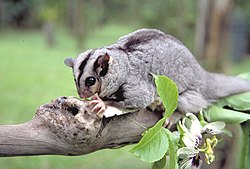Mahogany glider
| Mahogany glider | |
|---|---|
 |
|
| Scientific classification | |
| Kingdom: | Animalia |
| Phylum: | Chordata |
| Class: | Mammalia |
| Infraclass: | Marsupialia |
| Order: | Diprotodontia |
| Family: | Petauridae |
| Genus: | Petaurus |
| Species: | P. gracilis |
| Binomial name | |
|
Petaurus gracilis (de Vis, 1883) |
|
 |
|
| Mahogany glider range | |
The mahogany glider (Petaurus gracilis) is an endangered gliding possum native to a small region of coastal Queensland in Australia.
A nocturnal arboreal marsupial, the mahogany glider closely resembles the sugar glider, the squirrel glider and the yellow-bellied glider, but is noticeably larger than any of its relatives (26.5 cm long and 410 g) and long tail (34–40 cm). The species gets its common name from its mahogany-brown belly and the similar colour of its patagium, or gliding membrane. The tail is covered in short hair, and is black on the underside.
These gliders are sexually dimorphic, with the males being larger than the females, although the latter usually have a longer tail in proportion to their body. In terms of their body length, females are marginally smaller, measuring 23 to 27 centimetres (9.1 to 10.6 in) compared with the male body length of 23 to 28 centimetres (9.1 to 11.0 in), but they have a slightly longer tail, measuring 35 to 41 centimetres (14 to 16 in) compared with 34 to 41 centimetres (13 to 16 in) in males. However, despite their similar apparent size, the females, at 310 to 454 grams (10.9 to 16.0 oz), are much more lightly built than the males, which weigh between 345 and 500 grams (12.2 and 17.6 oz).
The mahogany glider is restricted to a very small area, between Ollera Creek south of Ingham and Tully in North Queensland, Australia. The habitat consists mainly of open forest with many different flowering plants that provide year round food.
The mahogany glider has a long breeding season with births starting April and ending in October. Litters consist of one or two young, and are usually born once a year, although a mother can give birth to a second litter if the first is lost before leaving the pouch. The young are weaned at four to five months, and reach sexual maturity at twelve to eighteen months. They have been recorded to live to about five or six years of age.
Each pair of adults shares some of their dens with offspring from the previous breeding season. These dens are marked and defended from other mahogany gliders. The pairs are usually monogamous, although extra-pair matings have been observed.
...
Wikipedia

